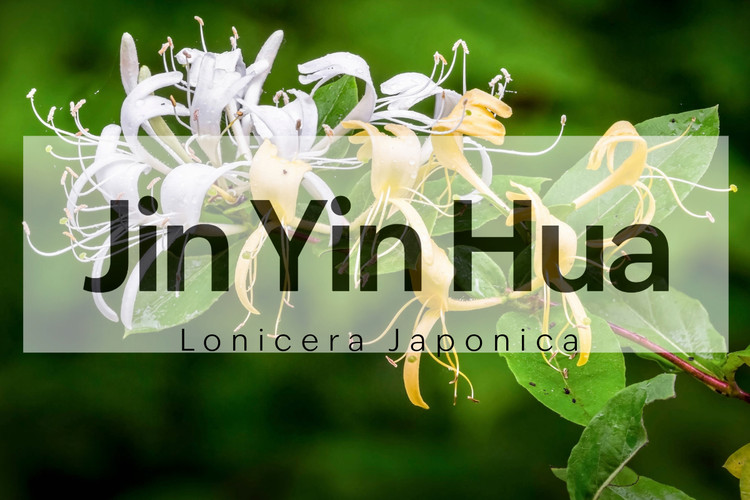Posted by Frank Griffo on Jun 4th 2025
Jin Yin Hua - Honeysuckle
Sounds as sweet as it is effective.
Historical Significance
Jin Yin Hua, Lonicera japonica, has long been cherished for its ability to “clear heat and relieve toxicity.” Its name, meaning “gold and silver flower,” is thought to reflect the flower’s transformation from white to yellow as it blooms. This plant’s dual-colored name has been metaphorically linked to its ability to treat both the early and late stages of febrile disease.
One tale from Jiangsu province tells of a young girl who was guided by a dream to use the flower to cure a deadly plague, earning Jin Yin Hua a reputation as a guardian against epidemics. This story and more underscore the herb’s long-standing role in both daily clinical use and symbolic folklore.
Historically, Jin Yin Hua was first recorded in the Han dynasty. The herb is praised not only for its clinical utility but also for its “sweet nature and heavenly fragrance,” which earned it nicknames like “Fairy Vine.” Jin Yin Hua gained prominence in the Compendium of Materia Medica by Li Shizhen, who emphasized its gentle yet effective capacity to clear epidemic heat and resolve swellings.
Botanical Profile
Jin Yin Hua refers specifically to the dried flower buds (and sometimes early flowers) of Lonicera japonica, a twining vine native to East Asia. The plant thrives in warm, humid environments and is widely cultivated in China, especially in provinces like Shandong, Henan, and Hubei.
According to Bensky’s Materia Medica, the best quality Jin Yin Hua is harvested just before the buds fully open, when their volatile oils and active constituents are at their peak. The buds are carefully dried in the shade to preserve color and aroma—key indicators of quality. Flowers that are overly open or discolored are considered inferior.
Traditional Functions
In traditional Chinese medicine, Jin Yin Hua is classified as:
- Nature: Sweet, Cold
- Channels Entered: Lung, Heart, Stomach
- Functions: Clears Heat and resolves toxicity; disperses Wind-Heat;
Jin Yin Hua is used across a wide range of excess heat presentations, from febrile disease and sore throat to abscesses, boils, and hot skin rashes. Its cooling, light nature makes it suitable for early-stage febrile illnesses with sore throat and thirst, as well as localized infections with redness and swelling.
Its sweet flavor, combined with its cold nature, gives it a unique ability to cool without damaging the Spleen. This makes it safer for long-term or higher-dose use compared to more bitter-cold herbs.
Paired Herbs
Jin Yin Hua’s versatility is often enhanced by combining it with synergistic herbs:
- Lian Qiao (Forsythiae Fructus): This is perhaps the most iconic pairing. Together, they form the core of Yin Qiao San, a go-to formula for Wind-Heat invasion. Lian Qiao helps expel Wind and dissipate nodules, while Jin Yin Hua clears heat and toxicity.
- Pu Gong Ying (Taraxaci Herba): Used together for mastitis, skin infections, and abscesses, this pairing emphasizes Jin Yin Hua’s ability to move heat out of the blood and tissues.
- Huang Qin (Scutellaria baicalensis): When systemic inflammation is more pronounced, this duo clears both exterior and interior heat, especially from the upper burner.
- Zi Hua Di Ding (Viola): Enhances the herb’s skin-purging and anti-suppurative actions, great for furuncles and carbuncles.
Formulas Containing Jin Yin Hua
At Griffo Botanicals, we rely on Jin Yin Hua’s broad-spectrum anti-inflammatory and detoxifying qualities in several of our key formulas:
- Febris: Our Yin Qiao San, Febris contains Jin Yin Hua to help dispel heat lodged in the wei and qi levels, support sore throats, and address viral inflammation in its early stages. It plays a central role in modulating immune reactivity and cooling febrile tension without being overly draining.
- Dermaleaf: Our Wu Wei Xiao Du Yin, Jin Yin Hua helps reduce inflammatory skin eruptions, eczema, and heat-toxin rashes. Its ability to cool blood and move toxicity makes it indispensable in acute dermatological flare-ups.
- Gan Mao: Gan Mao Ling, Jin Yin Hua clears heat, is anti-bacterial and anti-viral, and clears inflammation in an infection’s early stages.
In clinical practice, we also use Jin Yin Hua in custom powders for patients with:
- Recurrent UTIs with heat and burning
- Post-exercise sprains with redness and swelling
- Abscesses
Its inclusion ensures a cooling, antimicrobial, and anti-inflammatory foundation that we build around based on pattern.
Pharmacology and Modern Applications
Modern research supports much of what classical Chinese medicine has long observed. Jin Yin Hua has demonstrated:
- Antiviral activity: Studies have shown it inhibits influenza A and B, adenoviruses, and even SARS coronavirus replication. The active constituents—chlorogenic acid, luteolin, and lonicerin—are considered responsible for its viral-suppressing effects.
- Antibacterial effects: Effective against Staphylococcus aureus, E. coli, and Pseudomonas aeruginosa, making it a valuable adjunct in skin infections, UTIs, and upper respiratory bacterial overgrowth.
- Anti-inflammatory actions: Jin Yin Hua downregulates pro-inflammatory cytokines like TNF-alpha and IL-6, reducing systemic inflammation markers. This explains its role in managing fever, skin outbreaks, and sprains.
- Immunomodulation: According to Chen, Jin Yin Hua modulates immune response by both enhancing phagocytic activity and stabilizing overactive immune states, especially during viral infections.
- Gastroprotective and hepatoprotective: Animal models show that extracts of Jin Yin Hua can protect liver function and reduce gastric mucosal inflammation. This may explain its historical use in dysentery and food-borne illness.
- Antioxidant properties: High levels of flavonoids and phenolic acids contribute to its anti-aging and tissue-healing capabilities.
Chen, J., & Chen, T. (2004). Chinese Medical Herbology and Pharmacology (pp. 291–294).
These findings validate its wide clinical use—not just for infections, but also for inflammatory conditions such as arthritis, eczema, and even early metabolic syndrome.
Final Thoughts
Jin Yin Hua is one of the most valuable and versatile herbs in the Chinese materia medica and it is one of my absolute favorites in the clinic. Its ability to clear heat toxicity, reduce inflammation, and fight infection make it indispensable.
As a clinician, it’s rare to find an herb that is so effective, safe and tolerable. Its sweet flavor makes it palatable in teas or tinctures. As with many of my favorite herbs, it’s the balance of function, safety, and beauty that makes Jin Yin Hua indispensable.
For us at Griffo Botanicals, it continues to be a backbone in several formulas—quietly doing its work, just as it has for centuries.


